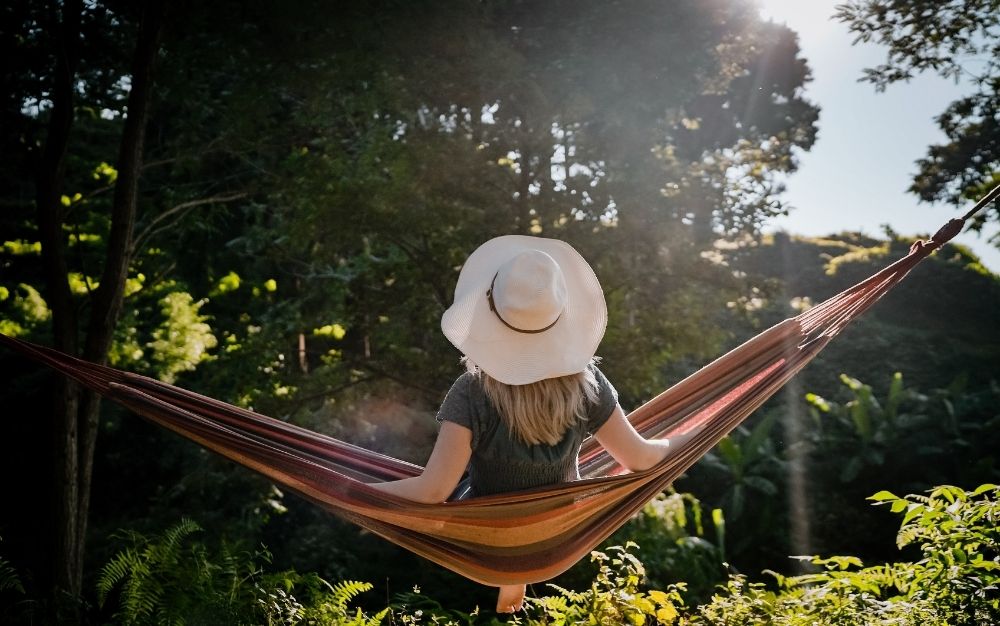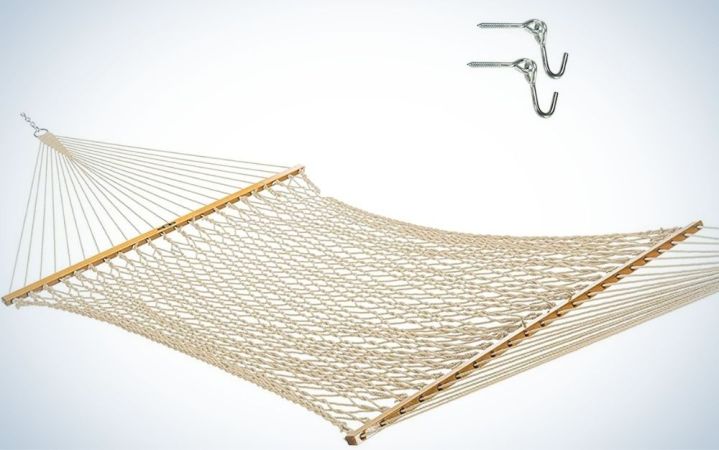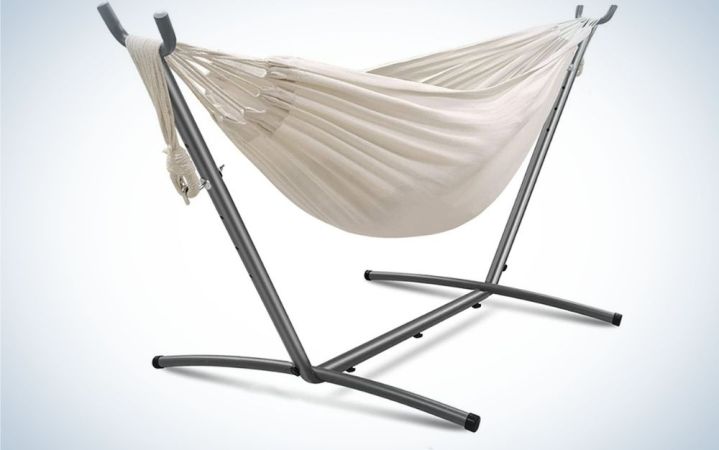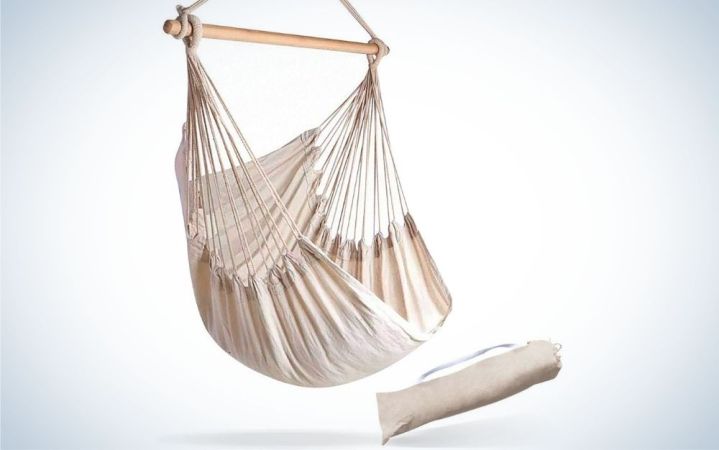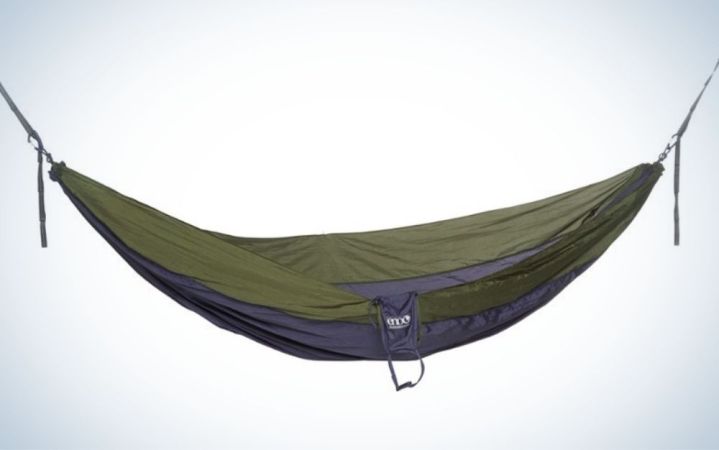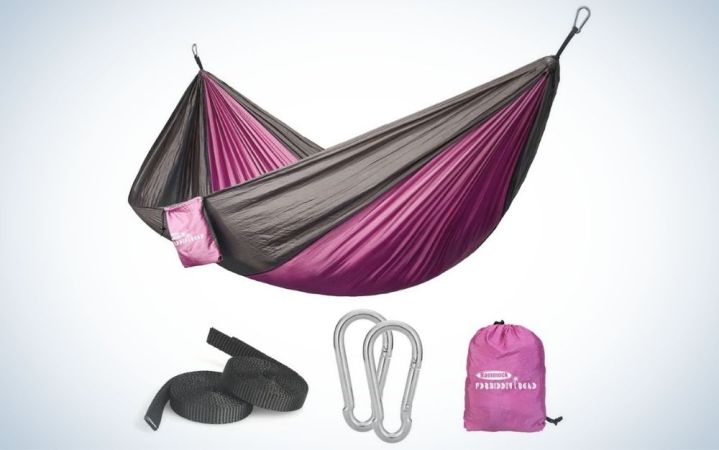We may earn revenue from the products available on this page and participate in affiliate programs. Learn More ›
Everybody knows that the gentle rocking of a hammock is pleasurable, but a group of Swiss scientists say the slow motion of a hammock actually makes people fall asleep more quickly and sleep more deeply. Their test subjects napped in a bed designed to mimic the slow swaying of a hammock while electrodes attached to their scalps charted their brain activity.
It turned out that sleeping in a swaying hammock increased non-REM N2 sleep, which is the bulk of a good night’s rest. It also increased slow brain waves and sleep spindles. Sleep spindles are quick blasts of brain activity that have been linked with memory and the brain’s ability to adapt to experiences.
Those findings could help people recovering from strokes or brain injuries as well as people dealing with insomnia and other sleep disorders. But the benefits of deeper sleep that come with a swaying hammock are available to everybody. The best hammock—whether a traditional outdoor hammock, contemporary indoor hammock, or camping hammock—is a great tool to enhance your health and well-being. Or, just laze away an afternoon.
- Best Hammock for Outdoors: Pawleys Island Hammock
- Best Hammock with Stand: Indoor/Outdoor Hammock with Stand
- Best Hammock Chair: Hammock Sky Hammock Chair
- Best Camping Hammock: Eagles Nest Camping Hammock
- Best Cheap Hammock: Forbidden Road Camping Hammock
The History of Hammocks: Sleeping Made Safe
The best hammocks on the market today range from simple to extravagant. You can find traditional backyard hammocks, two-person hammocks, tent hammocks, hammock chairs, and even enormous aerial hammock beds that can hold an entire family.
But hammocks aren’t new inventions. Most historians say hammocks, made of netting to allow for comfortable sleep, originated within Indigenous communities in the Caribbean long before Europeans set sail for the Americas. In tropical climates, hammocks provide protection from venomous animals like snakes and ants and make it simple to wrap mosquito netting around sleepers to prevent deadly insect-borne illnesses.
Pretty soon, hammocks were showing up throughout Europe and the Americas—especially as space-saving sleeping systems on merchant and military ships as well as frontier farms. Many of these were made from canvas, which could get sweltering, thanks to reduced airflow.
Some of the very first commercially sold hammocks in the United States were rope hammocks with spreaders. These are made with cotton or polyester rope woven and knotted through oak staves for better airflow and durability.
Quality is Key for Outdoor Hammocks
As with all outdoor gear, outdoor hammocks need special attention to withstand constant exposure to the elements. Hammocks built from lower-quality materials simply won’t hold up to heavy outdoor use.
Hammocks for use outdoors should be made of materials that will resist mold or mildew. Look for blends labeled weather-resistant or mold-resistant, especially for hammocks that will be kept outside year-round. Some good options are mold-resistant cotton blends and weather-resistant nylon.
Wood spreader bars should be treated with a weather-resistant coating to keep the wood from breaking down or warping over time.
Best Hammock for Outdoors: Pawleys Island Hammock
Pawleys Island Hammocks’ original design includes all-weather rope and oak staves coated in marine-grade varnish to protect the hammock from mold and damage. This one holds 450 pounds and includes extension chains and tree hooks.
Best Hammock with Stand: Swaying without Trees
Traditionally, hammocks are hung suspended from a pair of trees or sturdy posts. When that’s not possible, so a free-standing hammock is an alternative.
The first consideration when it comes to a hammock with a stand is the quality of the stand itself. These should be constructed of heavy-duty steel that’s treated with rust protection. Look for a hammock stand that pops together without special tools to make the setup simple.
Hammocks used indoors are less likely to have problems with mold, mildew, and rust. A stand hammock that easily disassembles into a carrying case may be a good option for people who want to store the hammock during rainy or snowy weather—and also for those who want to pack the hammock along on vacation.
Best Hammock with Stand: Indoor/Outdoor Hammock with Stand
When you don’t have a pair of trees handy, this hammock and stand is easy to set up—outside or inside. It holds 450 pounds and comes with a convenient carrying case so you can take it on the road.
Best Hammock Chairs for Porches and Smaller Spaces
While it’s luxurious to stretch out on a full-length hammock, sometimes space constraints make that difficult. For smaller spaces like porches or indoor installations, consider a hammock chair.
Hammock chairs use a smaller footprint by folding the hammock so the user is more upright.
Since these hammocks install into the ceiling, it’s imperative to locate a stud. Then, install an eye hook weight-tested for the hammock’s weight limit. This is generally 300 to 450 pounds, depending on the manufacturer and materials.
Best Hammock Chair: Hammock Sky Hammock Chair
If you’re tight on space, a hammock chair gives you all the sway but at half the length. This option holds 300 pounds and is suitable for indoor or outdoor use.
Sleep in the Trees with Best Hammock for Camping
Slowly swaying in a hammock in the yard with a book and lemonade might be one way to do hammocks, but the place where hammocks really shine is camping. Many backpackers and campers who prefer to travel light appreciate how small a camping hammock folds up into a backpack. Camping hammocks are both tent and mattress, cradling your body well above the hard, rocky ground while shielding you from weather, dropping vegetation, and dew.
Camping hammocks are also easy to set up since they only require two trees. That means no more messing with tent poles or pounding in stakes. And for campers who prefer a cushier camping experience, a camping hammock is an excellent alternative to inflating an air mattress.
Look for a folding hammock made of high-quality, quick-dry materials for longevity. A good camping hammock will include a carrying pouch for easy packing. The best options feature insect netting to keep your aerial sleeping system bug-free.
Best Camping Hammock: Eagles Nest Camping Hammock
The hammock-tent system is made of durable, quick-dry nylon and includes an aerial suspension system. For protection from the weather and biting insects, simply install the rain fly and fine-mesh bug net. This one holds 400 pounds.
Budget Hammocks: What You Get for Less Than $16
High-quality hammocks are luxurious and long-lasting, but budget-friendly hammocks are a great option—especially for people who want to try out an outdoor hammock or camping hammock without making a huge investment up front.
Since these hammocks may be manufactured with less durable materials, it’s a good idea to keep the hammock out of the elements and check it frequently for signs of wear. Higher-quality rope hammocks will be woven without knots in the portion of the hammock that will actually hold your body since these can be uncomfortable—so it’s a good idea to look for this feature in budget-friendly hammocks as well.
Best Cheap Hammock: Forbidden Road Camping Hammock
Forbidden Road’s camping hammock is a simple nylon sport hammock—plus everything you to hang it and pack it. This hammock holds 400 pounds.
FAQs
The best hammock for sleeping is a hammock that feels good to your individual body. Many people like a supportive fabric hammock for sleeping, but people who live in hotter climates may prefer the open design of a woven rope hammock. Look for an option without knots in the area that cradles your body to ensure uninterrupted slumber.
Hammocks with spreader bars are better in some situations. This design is easier to get into or out of, so it may be preferable for people who are less flexible—or for people who want to swing in a hammock with a child. These hammocks also dry more quickly since they are spread open, so they are a great choice for hammocks near pools or that are exposed to rain or dew. When it comes to aesthetics, some people prefer the look of a hammock with spreader bars while others prefer the traditional-style hammock.
Hammocks are worth it for people who find the gentle swaying of the hammock relaxing—or who want the proven brain benefits of using a hammock. High quality hammocks are an investment that will last many years, but people who aren’t sure if they want to invest in a luxury hammock can look for a budget-friendly hammock and then upgrade at a later time.
The Final Word on Hammocks: Health
The best hammocks are designed to cradle your body and bring all the brain benefits of that sweet swaying motion. Whether you prefer a traditional outdoor hammock, a hammock with a stand, a hammock chair, or a camping hammock, a quality hammock will boost your health and well-being for years to come.
